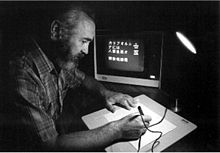Hewitt Crane
| Hewitt D. Crane | |
|---|---|

Hewitt Crane demonstrates pen-input computing for writing Chinese characters at SRI International
|
|
| Born | 1927 Jersey City, New Jersey |
| Died | June 17, 2008 (aged 81) Portola Valley, California |
| Employer |
United States Navy IBM Institute for Advanced Study RCA Laboratories SRI International Ridge Vineyards |
| Known for | Electronic Recording Machine, Accounting |
| Awards | IEEE Fellow |
Hewitt D. Crane (1927–2008) was an American engineer best known for his pioneering work at SRI International on ERMA (Electronic Recording Machine, Accounting), for Bank of America, magnetic digital logic, neuristor logic, the development of an eye-movement tracking device, and a pen-input device for computers.
Crane was born in 1927 in Jersey City, New Jersey. After a stint in the United States Navy as a radar technician during World War II, he worked as a computer maintenance technician for IBM (1949–1952), followed by working on digital computer design under the leadership of John von Neumann at the Institute for Advanced Study, in Princeton, New Jersey (IAS is not affiliated with Princeton University).
He then developed magnetic multiaperture devices (MADs) at RCA Laboratories (now Sarnoff Corporation). In order to develop magnetic logic, Crane controlled the direction of bit flow in magnetic ferrite memory cores.Ferrite logic circuits are inherently more stable than vacuum tubes and transistors, draw no power when unused, and are impervious to electromagnetic interference. In 1959, Crane introduced the all-magnetic logic approach at the Fall Joint Computer Conference, eventually leading to a demonstration of the world's first all-magnetic computer in 1961. The technology was soon commercialized by Aircraft Marine Products (AMP) Inc., under license from SRI, and used primarily in the rapid transit system of New York City and at railroad switching yards, where electro-magnetic interference made electronic computers unfeasible. The development and growth of planar transistors in silicon chips and integrated circuits displaced magnetic core logic, although it may still be useful for extended space missions and other extreme conditions, but using integrated circuit manufacturing techniques (e.g. etching and deposition of a substrate, and not an assembly of discrete magnetic cores). The prototype of the first all-magnetic computer now resides at the Computer History Museum, in Mountain View, California.
...
Wikipedia
